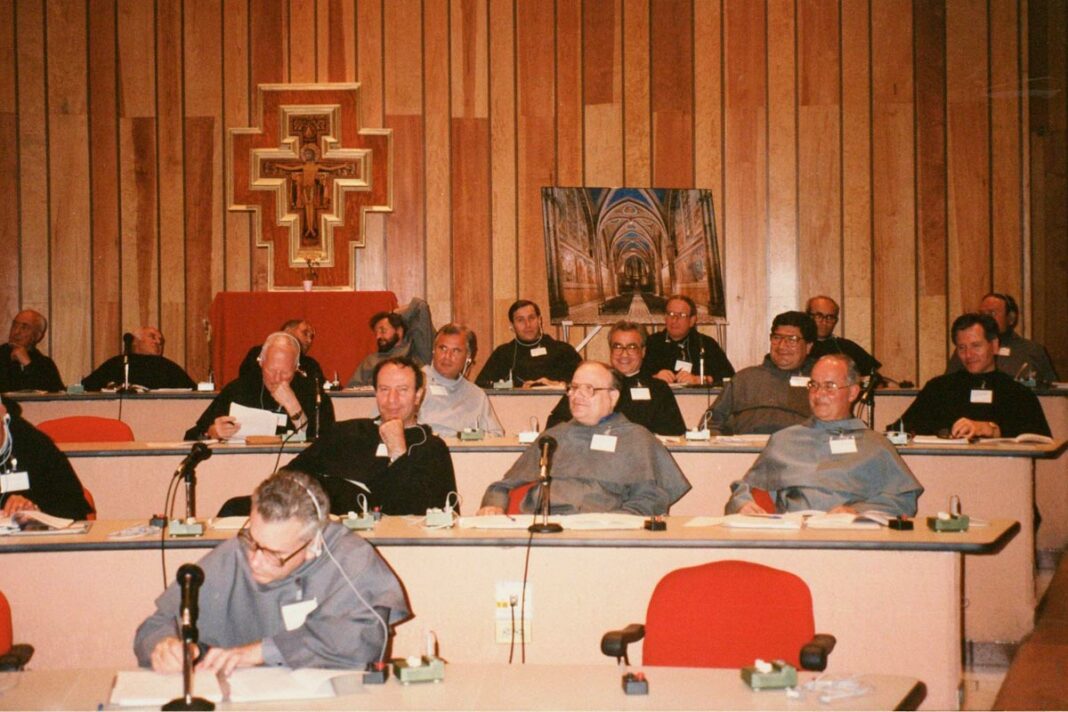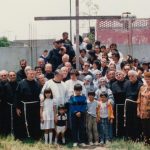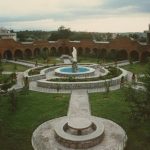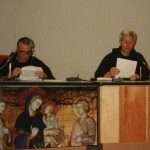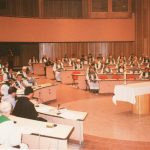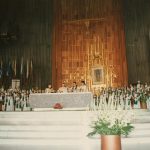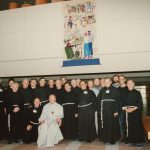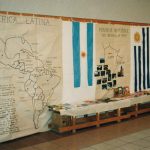“Peace, Justice and the Safeguarding of Creation”
I shall briefly touch on the other two documents produced by the Chapter in Mexico and offer some general information about them.
The text of “Peace, Justice and the Safeguarding of Creation” is a sort of grand message inspired by what was then called the “Spirit of Assisi.” That was the extraordinary event celebrated on October 27, 1986, in Assisi, at the behest of St. John Paul II. The meeting had been convened to pray for peace and brought together high-ranking representatives from many of the world’s religions.
The work of the Chapter began with an introductory a report by Friar Peter Damian MASSENGILL, then the General Delegate for Justice, Peace and the Safeguarding of Creation. The report gave the Capitulars a better understanding of this broad and complex topic.
The document “Peace, Justice and the Safeguarding of Creation” first presented a broad picture of the global situation at that time, as regarded the three areas evoked in the title. The situation has certainly not improved since then. The document noted that, although humanity enjoys the benefits offered by the development of science and technology, and that positive social awareness is increasing, “the second millennium is coming to an end in a controversial world, one full of projects and tensions, hopes and fears, light and darkness.” It then examined the many negative realities afflicting humanity and noted “our consciousness is raised by the fact that we are celebrating our General Chapter in a Latin American country, in a martyred continent and a land of immense suffering and great hopes for the Church, where there are already many martyrs of charity who have given their life to defend and help the most poor. Among these are also four of our confreres.” The document examined a list of negative elements afflicting the world in some detail. It went over the many different kinds of poverty there are. It pointed out many violations of life and human dignity, particularly the fundamental human rights of each person. It talked about the widespread practice of abortion, the still high infant mortality, the many forms of marginality and injustice, non-democratic regimes, discrimination of various kinds, new forms of colonialism, and so forth. It noted the widespread imposition of an economic and financial system that favors the rich, leading, once again, to the sad realization of a scheme that “makes the rich richer at the expense of the ever poorer poor.” Added to this was the irrational exploitation of the earth and its resources with all that derives from it.
Obviously, the more recent magisterium of the Church, particularly that of Pope Francis, gives us an updated picture of this situation today, showing us even more dramatic difficulties (cf. Evangelii gaudium, 52-60; 186-237; Laudato si’, 17-61).
Mindful of this global situation, about which no one could be indifferent, the document, considered the inspiring values coming from the Word of God, from the social magisterium of the Church, and from the figure and spirituality of St. Francis. It thus proposed that the Order remain firmly committed to Peace, Justice and the Safeguarding of Creation. This commitment was given particular emphasis, as expressed in these three statements:
“Faced with the many vast situations of injustice we, in the spirit and style of Francis, consider ourselves brothers of all men and women. Refusing every form of discrimination we recognize as brothers of special right those who are victims of every form of injustice: we see the presence of Jesus in them in a special way (cf. Mt 25).”
“Faced with situations of armed and unarmed conflict, which are before our very eyes, we wish to be men of peace always and everywhere.”
“Faced with all that threatens the reality of creation, the gift and vestige of divine wisdom and goodness, we wish to become promoters of real respect for nature, the dwelling place of people now and in the future.”
The document was then careful to illustrate, with very concrete instructions, how these commitments should take shape at various levels, such as the level of the individual friar, the community, etc.
Thus, we were called, as a religious family and as individuals, to take the side of the poor, the oppressed, the marginalized, and the exploited. We were called to focus our attention on all forms of injustice; to be heralds and promoters of justice not simply through words but through the commitment of our lives, through forgiveness and reconciliation, tolerance, acceptance and respect for all, through open and sincere dialogue, non-violence, and through a culture of life. Once again, we were called to raise our voices against all forms of exploitation of the planet. We were called to teach others the love of nature and to practice a sober lifestyle.
The document also acknowledged that the statements made “are very demanding and require a clear, firm and courageous stance.” It went on to say that we were not unaware of our limits; that we recognized we had to make a continuous effort at conversion by daily invoking the Lord’s help.
This particular Chapter text not only had the merit of setting out good intentions, it offered concrete instructions, taking into consideration the areas of fraternity, formation and service to humanity. It explained all of this at various levels: the individual friar, fraternal life in community, the Province, and of the entire Order, offering a set of interesting guidelines, which are certainly still valid today.
I remember this document had to undergo laborious debate. This was precisely because of the concrete proposals it was making. The proposals encountered disagreement and differing perspectives. This always happens when trying to turn principles into practical choices.
I believe, moreover, that the theme of justice, peace and the safeguarding of creation (this third element in particular) was a rather new element for the Capitulars to deal with. They were more accustomed to dealing with problems that were deeply internal to the Order or religious life. In fact, the General Delegate for Justice, Peace and the Safeguarding of Creation had only been instituted three years prior at the 1989 General Chapter. From this point of view, the Chapter of Mexico should be credited for having the courage to take a broad outlook, for focusing on caring for the world in the spirit of Gaudium et spes, and for knowing how to move forward in history with the prophetic vision that is being demanded of the Church today by the Christian “Hearers of the Word” and the authentic Franciscans of our time.
“The Study of the Franciscan Charism throughout the Various Stages of Formation”
I will devote only a short space to this third document. This is not because the topic of formation doesn’t deserve attention. On the contrary, formation is becoming ever more important in the ecclesial sphere and for those entering religious life or ordained ministry. Nevertheless, it can be said that the work on this topic during the Chapter in Mexico was part of a larger effort that started some time before. Moreover, the work on this topic continued, in particular, at the subsequent 1998 Extraordinary General Chapter (held in Ariccia), which produced a final document entitled “Formation in the Order: Guidelines for a Renewed Commitment.”
The Capitulars in Mexico dealt with this topic by undertaking reflection on how to offer the elements of the Franciscan charism to friars in initial and continuing formation, and how to help them assimilate those elements.
Before discussing this topic, the Assistant General for Formation, Friar Santos JÁTIVA MATEO, explained how the decision to deal with this topic was reached. Interestingly, the request had come from the formators of the Order. Evidently, there was a need to create a framework that would help them promote Franciscan studies and form men to live the Franciscan lifestyle in a way that was not improvised or vague, but precise and serious, through a needed, gradual approach, being mindful of differences in age, academic achievement and status among those being formed. This involved those who were exploring a vocation with the Order, as well as those taking part in continuing formation. This also included accepting the indications of the Church on formation in religious life.
Inspired by Franciscan Discipleship, the resulting document was divided into four sections aimed at four levels of formation. The first section, “First Steps in Discipleship,” dealt with vocational guidance for the postulancy or pre‑novitiate period. It was followed by sections on the novitiate, the post-novitiate, and continuing formation. Each section followed a common format, starting with an introduction addressing the concrete status of the man being formed; the objective or scope which would aid in his discovery of the Franciscan charism; the content to be offered and some possible themes to be proposed. The document concluded with a bibliography in several languages.
I will not elaborate further on this document because to illustrate it more precisely would be to transcribe it in its entirety. After all, as I mentioned, the Extraordinary General Chapter that followed six years later was substantially devoted to the theme of formation. It is notable that this decisive topic had also been given special attention at the Chapter in Mexico.
Some Interesting Appendices
The official text reporting what was produced by the General Chapter of Mexico did not end with the three documents presented. Those documents were followed by some additional noteworthy pages, which included:
A series of thirty-four Decrees drawn directly from the Chapter documents, with precise indications provided, duly and expressly approved by vote. For example: Decree no. 18, which declared that: “The situation of a friary with fewer than three friars over a period of three years should be evaluated and resolved by the Provincial Chapter” was taken directly from no. 55.2 of the document “Conventual Franciscan Presence and Witness toward the Year 2000.”
A series of fourteen Motions, namely, the practical directives, initiatives and calls to action that emerged during the Chapter discussions, which were not present, as such, in the documents. They had also been approved by the Chapter with a vote.
These Decrees and Motions intelligently set forth clear norms or indications as a means of truly implementing, even in an obligatory manner, everything that the Chapter had ordered put into action. In this way, nothing was allowed to “evaporate” into vague wishes or desires, or devolve into “possible” proposals, that were, in fact, left up to the discretion of the individual friar or Jurisdiction.
Next, there were three Declarations presented to the Chapter concerning the Order’s commitment in the former Soviet Union, the Province of Romania and the Province of Belgium.
Finally, there were fifteen fact sheets presented, presumably by the government of the Order. They deserve to be reported because they testify to the Order’s lively planning at that stage. The fact sheets were as follows:
1. Assisi – International Franciscan Center for Dialogue (CEFID)
2. Assisi – International Vocational Promotion Center (CIPV)
3. Rome – Franciscan Center for Environmental Studies – Similar Centers in Montevideo and Cracow
4. Vienna – German language seminar for aid to Austria and the Provinces of Eastern Europe
5. Lusaka – St. Bonaventure College Franciscan Formation Centre
6. Istanbul – Project for the preparation of clerical friars in the Turkish language and in ecumenical and interreligious dialogue, with an emphasis on Islam
7. Lebanon Project
8. France Project to revitalize the Order’s presence in that nation
9. Scandinavia Project: Sweden-Denmark
10. Hungary Project
11. Czechoslovakia project
12. Bulgaria and Eastern Greek Church Project
13. Projects in the former Soviet Union
14. Aid to Provinces in difficulty
15. Assisi – Caput et Mater totius Ordinis
Conclusion
I had entitled the first installment of the story of the Extraordinary General Chapter in Mexico “An Event Not to Be Forgotten.” For me, this retrospective was a pleasant way of coaxing a beautiful story from my memory. I would like to conclude with two simple points that came to mind during this process.
The first point is that there are common experiences and initiatives that we need to have. These deserve to be well prepared, without worrying too much about external forms, but rather, by really focusing on the contents, making sure that they truly help plot a course.
The second point brings us to the valuable statement made in Vita consecrata 42: “special importance attaches to Chapters…at which Institutes are called…to discern, in the light of the Spirit, the best ways to preserve and adapt their charism and their spiritual patrimony to changing historical and cultural situations.” I believe that the Chapter in Mexico skillfully put this wise suggestion into practice.
✠ Friar Gianfranco Agostino GARDIN
Treviso, Italy, November 18, 2022






